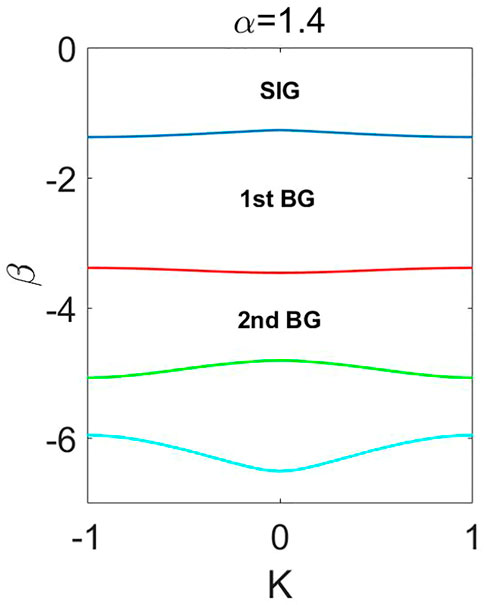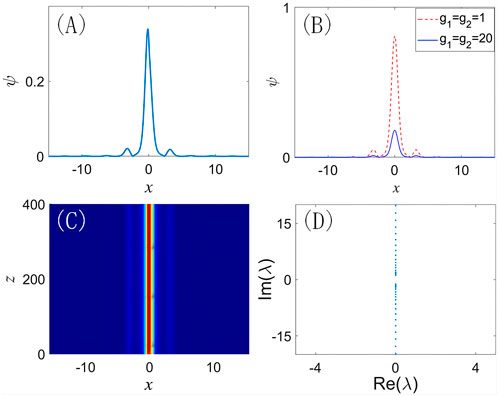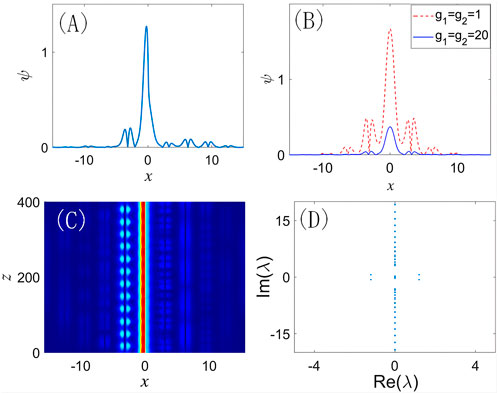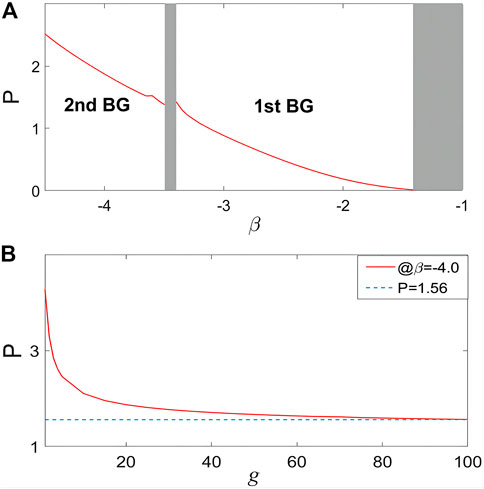- 1Institute of Fiber-Optic Communication and Information Engineering, College of Information Engineering, Zhejiang University of Technology, Hangzhou, China
- 2State Key Laboratory of Transient Optics and Photonics, Xi’an Institute of Optics and Precision Mechanics of CAS, Xi’an, China
- 3University of Chinese Academy of Science, Beijing, China
We investigate the existence and stability of localized gap states at a non-linear interface of non-linear fractional systems in a one-dimensional photonic lattice. By using the direct numerical simulations and linear stability analysis, we obtain the stability of the asymmetric localized gap states in the first and second finite gaps. Our theoretical results show that the power of the localized gap states decrease gradually as the increase of propagation constant and the non-linear landscape (non-linear coefficient ratio between the left and right interface), providing insights into soliton physics in non-linear periodic systems with fractional-order diffraction.
1 Introduction
Fractional order has been introduced in many branches of sciences in past decades, including the calculus theory [1], image processing [2], quantum mechanics [3–5], and system control [2], to name a few. In 2002, Laskin first proposed fractional Schrödinger equation (FSE) in quantum mechanics, describing the fractional quantum mechanics, with the Riemann integral over the Brownian trajectory being replaced by the Lévy flight trajectory; and by the way, the Riemann path on the brown trajectory is well described by the standard Schrödinger equation [3–5]. Subsequently, many phenomena in the systems with the fractional effect have been disclosed, such as fractional Hall effect [6], fractional quantum oscillation [7], etc. In 2015, Longhi proposed a spherical optical resonator that may realize the FSE in optics [8]. In recent years, the research based on the FSE became a subject of great interest.A myriad of numerical studies have been reported, including the propagation dynamics of various beams under fractional diffraction: zigzag and funnel-shaped propagation trajectory of chirped Gaussian beam [9], non-diffracting beam and conical diffraction of non-chirped Gaussian beam [10], abnormal interaction of Airy beam [11], self-focusing dynamics of Airy Gaussian vortex beam [12], and beam propagation management [13], etc. The stationary solutions of non-linear Schrödinger equation have always been an interesting field. Therefore, when the non-linear Schrodinger equation is expanded from the standard integer order to the fractional order, that is non-linear fractional Schrödinger equation(NLFSE), many intriguing localized states/modes were revealed, including spatial solitons supported by PT-symmetry, symmetric and antisymmetric solitons, fundamental solitons, multipole gap solitons, discrete vortex solitons, vortex solitons and gap solitons and so forth in Kerr nonlinearity [14–33].
On another hand, studies of solitons in periodic potentials have recently been extended to nonlinear scenarios, namely nonlinear lattices [34–40]. Besides, the emergent soliton phenomena in nonlinear media with inhomogeneous modulation of non-linearity have attracted a great interest of scientists from nonlinear community; various soliton structures were thus found, including localized states [41, 43–48], fundamental solitons [42], dissipative solitons [49, 50], vortex solitons [45, 46], truncated-Bloch-wave solitons [51], vortex soliton tori [46], and twisted vortex solitons rings [52].
Up to now, solitonic studies in the fractional nonlinear Schrodinger equation with periodic potentials are mainly focused on the homogeneous modulation of nonlinearity, while the solitons under the inhomogeneous modulation of nonlinearity have not been well studied. Relevant research reports in recent years also indicate that fractional diffraction has varying degree of influence on the properties of various solitons. Therefore, the physical system with fractional diffraction and inhomogeneous modulation of non-linearity may provide new insights into the formation and stability of localized states.
Herein we aim to investigate the shift degree and the corresponding power change of the localized states at a nonlinear interface of one-dimensional photonic lattices with inhomogeneous modulation of non-linearity and fractional diffraction. By using the linear stability analysis and direct perturbed propagation, we report numerical simulations for one-dimensional localized gap states, lying into the first finite gap and the second one of the associated linear Bloch spectrum, under value-changing Kerr nonlinear modulation, and obtain the corresponding stability properties and power dependency.
2 Model
The propagation of light in a one-dimensional photonic lattice with fractional diffraction can be described by the normalized NLFSE, which yields:
Here,
:
here, we define the associated non-linear coefficient ratio as

FIGURE 1. (Color online) Band-gap structure of linear spectrum
Next, we take the stationary soliton solution as
Here,
The stability is a very important issue for localized states. To this end, it is necessary to perform linear stability analysis of them. We take the perturbation solution of Eq. 3 as:
Here,
Then, by using the Fourier collocation method [54], we can obtain the unstable growth rate, and judge the linear stability of the localized states according to the real part
3 Numerical simulation and discussion
For discussion, the Lévy index is fixed at

FIGURE 2. (Color online) First-gap localized modes under propagation constant

FIGURE 3. (Color online) Second-gap localized modes under propagation constant

FIGURE 4. (Color online) Power of localized modes versus the associated propagation constant (A) and nonlinear coefficient ratio (B). (A) Nonlinear coefficient ratio
4 Conclusion
In the framework of the NLFSE, we studied numerically the dynamics of asymmetric modes in one-dimensional photonic lattices with the domain wall-like Kerr nonlinearity, in the first and second gaps of the underlying linear spectrum. We analyzed the properties of these localized states and studied their stability through direct numerical simulation and linear stability analysis. A significant feature is that the power of the asymmetric modes gradually decreases with increasing propagation constant and nonlinear coefficient ratio respectively. Our findings provide a controllable way to generate and manipulate localized states in physical systems with fractional diffraction and inhomogeneous non-linearity.
Data availability statement
The raw data supporting the conclusions of this article will be made available by the authors, without undue reservation.
Author contributions
SZ: Data Curation, Software, Visualization, Writing-Original Draft, Formal Analysis; JZ: Conceptualization, Methodology, Project Administration, Supervision, Validation, Visualization, Writing-Review and editing; YQ: Funding Acquisition, Project Administration.
Funding
This work was supported by the National Natural Science Foundation of China (NSFC) (61675184, 61275124 and 61405178).
Conflict of interest
The authors declare that the research was conducted in the absence of any commercial or financial relationships that could be construed as a potential conflict of interest.
Publisher’s note
All claims expressed in this article are solely those of the authors and do not necessarily represent those of their affiliated organizations, or those of the publisher, the editors and the reviewers. Any product that may be evaluated in this article, or claim that may be made by its manufacturer, is not guaranteed or endorsed by the publisher.
References
1. Ortigueira MD, Tenreiro Machado JA. What is a fractional derivative? J Comput Phys (2015) 293:4–13. doi:10.1016/j.jcp.2014.07.019
2. Piotr O. Discrete fractional calculus: Applications in control and image processing. Singapore: World Scientific (2015).
3. Laskin N. Fractional quantum mechanics and Lévy path integrals. Phys Lett A (2000) 268:298–305. doi:10.1016/s0375-9601(00)00201-2
4. Laskin N. Fractional quantum mechanics. Phys Rev E (2000) 62:3135–45. doi:10.1103/physreve.62.3135
5. Laskin N. Fractional schrödinger equation. Phys Rev E (2000) 66:056108. doi:10.1103/physreve.66.056108
6. Laughlin RB. Anomalous quantum Hall effect: An incompressible quantum fluid with fractionally charged excitations. Phys Rev Lett (1983) 50:1395–8. doi:10.1103/physrevlett.50.1395
7. Olivar-Romero F, Rosas-Ortiz O. Fractorization of the quantum fractional oscillator. J Phys Condens Matter (2016) 698:012025. doi:10.1088/1742-6596/698/1/012025
8. Longhi S. Fractional Schrödinger equation in optics. Opt Lett (2015) 40:1117–20. doi:10.1364/ol.40.001117
9. Zhang Y, Liu X, Belić MR, Zhong W, Zhang Y, Xiao M. Propagation dynamics of a light beam in a fractional Schrödinger equation. Phys Rev Lett (2015) 115:180403. doi:10.1103/physrevlett.115.180403
10. Zhang Y, Zhong H, Belić MR, Ahmed N, Zhang Y, Xiao M. Diffraction-free beams in fractional Schrödinger equation. Sci Rep (2016) 6:23645. doi:10.1038/srep23645
11. Zhang L, Zhang X, Wu. H, Li C, Pierangeli D, Gao Y, et al. Anomalous interaction of Airy beams in the fractional nonlinear Schrödinger equation. Opt Express (2019) 27:27936. doi:10.1364/oe.27.027936
12. He S, Malomed BA, Mihalache D, Peng X, Deng D, Yu X, et al. Propagation dynamics of abruptly autofocusing circular Airy Gaussian vortex beams in the fractional Schrödinger equation. Chaos, Solitons and Fractals. (2021) 142:110470. doi:10.1016/j.chaos.2020.110470
13. Huang C, Dong L. Beam propagation management in a fractional Schrödinger equation. Scientific Rep (2017) 7:5422. doi:10.1038/s41598-017-05926-5
14. Wu Z, Cao S, Che W, Yang F, Zhu X, He Y. Solitons supported by parity-time-symmetric optical lattices with saturable nonlinearity in fra -ctional Schrödinger equation. Results Phys (2020) 19:103381. doi:10.1016/j.rinp.2020.103381
15. Bo W, Liu W, Wang Y. Symmetric and antisymmetric solitons in the fractional nonlinear Schrödinger equation with saturable nonlinearity and PT-symmetric potential: Stability and dynamics. Optik (2022) 255:168697. doi:10.1016/j.ijleo.2022.168697
16. Shi J, Zeng J. 1D solitons in saturable nonlinear media with space fractional derivatives. Annalen der Physik (2020) 532:1900385. doi:10.1002/andp.201900385
17. Ren X, Deng F. Fundamental solitons in optical lattices with fractional-order diffraction. Opt Commun (2021) 495:127039. doi:10.1016/j.optcom.2021.127039
18. Zhu X, Yang F, Cao S, Xie J, He Y. Multipole gap solitons in fractional Schrodinger equation with parity-time-symmetric optical lattices. Opt Express (2020) 28:1631–9. doi:10.1364/oe.382876
19. Mejía-Cortés C, Molina MI. Fractional discrete vortex solitons. Opt Lett (2021) 46:2256–9. doi:10.1364/ol.421970
20. Li P, Malomed BA, Mihalache D. Vortex solitons in fractional nonlinear Schrödinger equation with the cubic-quintic nonlinearity. Chaos, Solitons and Fractals (2020) 137:109783. doi:10.1016/j.chaos.2020.109783
21. Zeng L, Zeng J. One-dimensional gap solitons in quintic and cubic-quintic fractional nonlinear Schrodinger equations with a periodically modulated linear potential. Nonlinear Dyn (2019) 98:985–95. doi:10.1007/s11071-019-05240-x
22. Li P, Malomed BA, Mihalache D. Symmetry-breaking bifurcations and ghost states in the fractional nonlinear Schrödinger equation with a PT-symmetric potential. Opt Lett (2021) 46:3267. doi:10.1364/ol.428254
23. Liu X, Malomed BA, Zeng J. Localized modes in nonlinear fractional systems with deep lattices. Adv Theor Simul. (2022) 5:2100482. doi:10.1002/adts.202100482
24. Huang C, Dong L. Gap solitons in the nonlinear fractional Schrödinger equation with an optical lattice. Opt Lett (2016) 41:5636–9. doi:10.1364/ol.41.005636
25. Dong L, Huang C. Double-hump solitons in fractional dimensions with a 𝒫𝒯–symmetric potential. Opt Express (2018) 26:10509–18. doi:10.1364/oe.26.010509
26. Huang C, Dong L. Dissipative surface solitons in a nonlinear fractional Schrödinger equation. Opt Lett (2019) 44:5438–5441. doi:10.1364/ol.44.005438
27. Xiao J, Tian Z, Huang C, Dong L. Surface gap solitons in a nonlinear fractional Schrödinger equation. Opt Express (2018) 26:2650–2658. doi:10.1364/oe.26.002650
28. Su W, Deng H, Dong L, Huang Z, Huang C. Stabilization of fundamental solitons in the nonlinear fractional Schrödinger equation with PT-symmetric nonlinear lattices. Chaos, Solitons and Fractals (2020) 141:110427. doi:10.1016/j.chaos.2020.110427
29. Huang C, Deng H, Dong L, Ye F. Fundamental solitons in the nonlinear fractional Schrödinger equation with a $\mathcal{PT}$ -symmetric potential. EPL (2018) 122:24002. doi:10.1209/0295-5075/122/24002
30. Chen J, Zeng J. Spontaneous symmetry breaking in purely nonlinear fractional systems. Chaos (2020) 30:063131. doi:10.1063/5.0006050
31. Zeng L, Zeng J. Fractional quantum couplers. Chaos, Solitons and Fractals (2020) 140:110271. doi:10.1016/j.chaos.2020.110271
32. Li L, Li H, Wen R, Leng F, Luo X. Gap solitons in parity-time-symmetric lattices with fractional-order diffraction. J Opt Soc Am B (2020) 37:488. doi:10.1364/josab.376975
33. Zeng L, Zeng J. Preventing critical collapse of higher-order solitons by tailoring unconventional optical diffraction and nonlinearities. Comm Un Phys (2020) 3:26. doi:10.1038/s42005-020-0291-9
34. Kartashov YV, Malomed BA, Torner L. Solitons in nonlinear lattices. Rev Mod Phys (2011) 83:247–305. doi:10.1103/revmodphys.83.247
35. Kartashov YV, Vysloukh VA, Torner L. Soliton shape and mobility control in optical lattices. Prog Opt (2009) 52:63.
37. Guo D, Xiao J, Dong L, Jin H. One- and two-dimensional bright solitons in inhomogeneous defocusing nonlinearities with an antisymmetric periodic gain and loss. Physica.D. (2017) 343:1–6. doi:10.1016/j.physd.2016.11.005
38. Zeng L, Zeng J. One-dimensional solitons in fractional Schrödinger equation with a spatially periodical modulated nonlinearity: Nonlinear lattice. Opt Lett (2019) 44:2661–2664. doi:10.1364/ol.44.002661
39. Maimistov AI. Solitons in nonlinear optics. Quan Electron (2010) 40:756–81. doi:10.1070/qe2010v040n09abeh014396
40. Dudley John M, Frédéric D, Miro E, Goëry G. Instabilities, breathers and rogue wave in optics. Nat.photon. (2014) 8:755.
41. Liangwei D, Huang C, Qi W. Nonlocal solitons in fractional dimensions. Opt.Lett. (2019) 44:4917–4920. doi:10.1364/ol.44.004917
42. Borovkova OV, Kartashov YV, Torner L, Malomed BA. Bright solitons from defocusing nonlinearities. Phys.Rev E (2011) 84:035602. doi:10.1103/physreve.84.035602
43. Driben R, Kartashov YV, Malomed BA, Meier T, Torner L. Soliton gyroscopes in media with spatially growing repulsive nonlinearity. Phys Rev Lett (2014) 112:020404. doi:10.1103/physrevlett.112.020404
44. Huang C, Li C, Dong L. Gap solitons in fractional dimensions with a quasi-periodic lattice. Annalen Der Physik (2019) 531:1900056. doi:10.1002/andp.201900056
45. Chen R, Dai C. Three-dimensional vector solitons and their stabilities in a Kerr medium with spatially inhomogeneous nonlinearity and transverse modulation. Nonlinear Dyn (2017) 88:2807–2816. doi:10.1007/s11071-017-3413-5
46. Li L, Liu Y, Yu F. Some reverse space (RS) rational solutions for the nonlocal coupled nonlinear Schrödinger equations on the plane wave backgrounds. Appl Math Lett (2022) 129:107976. doi:10.1016/j.aml.2022.107976
47. Li L, Yu F, Duan C. A generalized nonlocal Gross-Pitaevskii(NGP) equation with an arbitrary time-dependent linear potential. Appl Math Lett (2020) 110:106584. doi:10.1016/j.aml.2020.106584
48. Yu FJ, Liu CP, Li L. Broken and unbroken solutions and dynamic behaviors for the mixed local-nonlocal Schrödinger equation. Appl Math Lett (2021) 117:107075. doi:10.1016/j.aml.2021.107075
49. Huang C, Dong L, Zhang X. Asymmetric dissipative solitons in a waveguide lattice with non-uniform gain–loss distributions. Opt Lett (2020) 45:6699–6702. doi:10.1364/ol.409577
50. Wang R, Wang Y, Dai C. Dissipative solitons of the nonlinear fractional Schrödinger equation with PT-symmetric potential. Optik (2022) 254:168639. doi:10.1016/j.ijleo.2022.168639
51. Dong L, Tian Z. Truncated-Bloch-wave solitons in nonlinear fractional periodic systems. Ann Phys (2019) 404:57–65. doi:10.1016/j.aop.2019.02.017
52. Kartashov YV, Malomed BA, Shnir Y, Torner L. Twisted toroidal vortex solitons in inhomogeneous media with repulsive nonlinearity. Phys Rev Lett (2014) 113:264101. doi:10.1103/physrevlett.113.264101
53. Yang J, Lakoba TI. Universally-convergent squared-operator iteration methods for solitary waves in general nonlinear wave equations. Stud Appl.Math (2007) 118(2):153–197. doi:10.1111/j.1467-9590.2007.00371.x
Keywords: nonlinear localized states, photonic lattice, inhomogeneous nonlinear modulation, fractional diffraction, kerr nonlinearity
Citation: Zhou S, Zeng J and Qin Y (2023) Asymmetric localized states at a nonlinear interface of fractional systems with optical lattices. Front. Phys. 10:1116344. doi: 10.3389/fphy.2022.1116344
Received: 05 December 2022; Accepted: 27 December 2022;
Published: 26 January 2023.
Edited by:
Yakup Yildirim, Near East University, CyprusReviewed by:
Yiqi Zhang, Xi’an Jiaotong University, ChinaFajun Yu, Shenyang Normal University, China
Copyright © 2023 Zhou, Zeng and Qin. This is an open-access article distributed under the terms of the Creative Commons Attribution License (CC BY). The use, distribution or reproduction in other forums is permitted, provided the original author(s) and the copyright owner(s) are credited and that the original publication in this journal is cited, in accordance with accepted academic practice. No use, distribution or reproduction is permitted which does not comply with these terms.
*Correspondence: Jianhua Zeng, emVuZ2poQG9wdC5hYy5jbg==; Yali Qin, eWxxaW5Aemp1dC5lZHUuY24=
 Shu Zhou1,2
Shu Zhou1,2 Jianhua Zeng
Jianhua Zeng